Both astronomy and research on currents of plasma in laboratory simulations confirm knowledge of vortices as described in Oahspe, which appeared prior to any of the modern technologies that could prove the existence of the vortex and vortexian currents.
In Oahspe's descriptions of the vortex we learn that all corporeal matter is a manifestion of the action of the vortex, thus suns and other planetary bodies are made and maintained by the action of the vortex.
The configurations of the vortex at various stages of development are described in Oahspe, Bk of Cosmogony and Prophecy, there are also a number of images of the stages of the vortex. Oahspe also tells that the Ghans (modern man) were taught about the vortex as early as Cpenta-Armij's cycle (beginning c. 6000 years ago).
Thunderbolts, Electric Universe websites have some interesting articles on the subject of current flow in plasma and its apparent depiction in ancient petroglyphs (rock carvings) and pictographs (rock paintings), which relate to the configuration of the vortex as Oahspe has revealed.
The links below connect to these articles and images.
http://www.thunderbolts.info/tpod/2004/arch/041231predictions-rock-art.htm
http://www.thunderbolts.info/tpod/2005/arch05/050506plasma-rock-art.htm
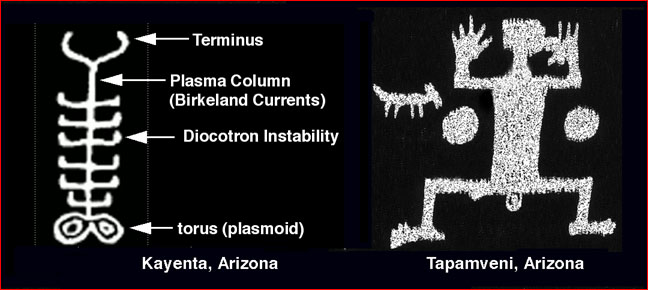
“Squatter Man” and
“Kayenta and Squatter Petros” images gathered by A Perrat courtesy of http://www.thunderbolts.info
In researching the configuration of a current within a
plasma circuit (electrically charged particles), Anthony Peratt discovered
certain shapes that were also evident in ancient rock art, these
ancient figures are found universally around the world in sites in
Europe, North and Central America, Mediterranean and the Middle East,
and are considered to be from 4,000 to 12,000 years old.
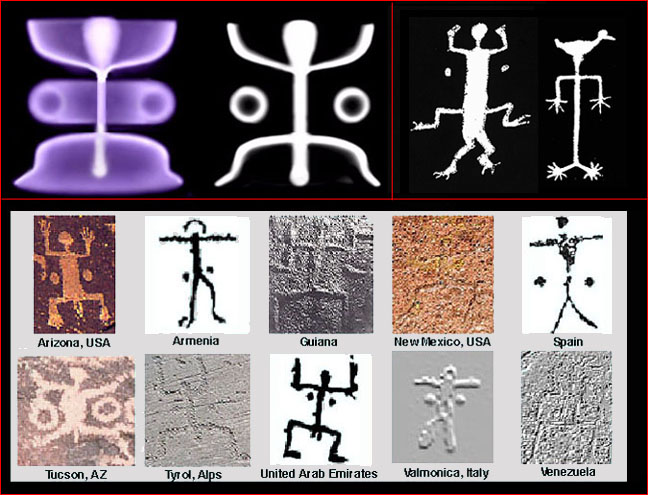
In Oahspe, the third and fourth ages of the vortex, plate 27 and 28,
have features like those described by Peratt
in the petroglyph images he presents. In Oahspe's images, can be seen the same
configurations where the head and tail of the vortex are
differentiated by the bulb at the top and the tail's outward then inward
curve at the bottom. The two areas at each side where the satellites
begin to form in plate 27 (the third stage of the vortex), are also
clearly distinguished in Peratt's plasma configurations and those of
the ancient rock art. Compare these images to see these
parallels.
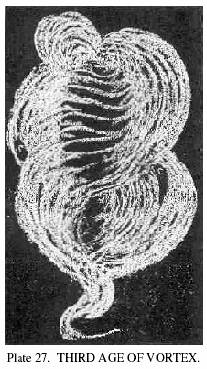
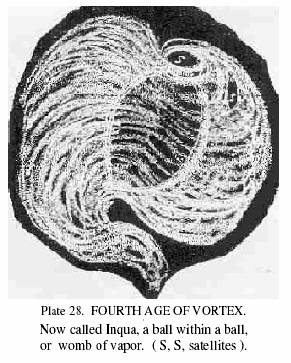 Bk of Cosmogony and Prophecy, 3,
Bk of Cosmogony and Prophecy, 3,
||25. Though the general form of a vortex, as before
stated, in its
beginning is long, funnel-shaped
(like a whirlwind), its ultimate is
toward a globular form.
And though the current of a vortex is spiral,
at first,
its currents ultimate toward less spirality. If one could
imagine
a very long serpent in spiral form, constantly turning its
head in at one pole, and its tail at the other,
and forever crawling
upon its own spirality, such a view
would somewhat illustrate the
currents of a vortex.
26. In one plate (plate 28, Fourth Stage of the Vortex)
the black
center represents a planet, and the black spot
with the letter "S"
represents a satellite. The white lines
indicate the course of the
vortexian currents, but purposely
exaggerated in the drawing. First,
to show the undulation in
the vortex where the satellite rests, and
secondly, to show
the head turning in at one end, and the bulge of
the tail ready to overlap itself, wherefrom there is an
excess of
light manifested in the tail (northern) regions.||
Another aspect of the configuration of the vortex is highlighted in
a commentary from the Electrical Universe Perspective on a
spectacular astronomical X-ray image of what
appears as a huge nebulous Ourorobos (a circle in the form of a snake
consuming its own tail) around a star.
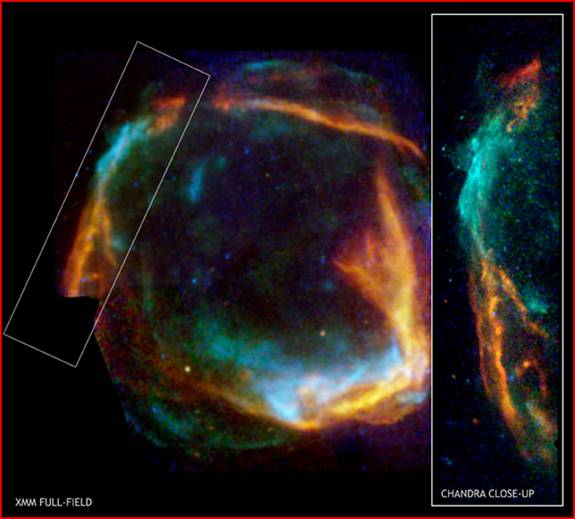
http://thunderbolts.info/tpod/2007/arch07/070911stellarouroboros.htm
Extract: ||............The image (right) emphasizes the ring structure around such stars. Because plasma is composed of some fraction of charged particles, its movement constitutes an electric current. In fact, space plasmas are generally laced with networks of filamentary currents. The rings are toroidal circuits coupled to and driven by the hourglass-shaped current sheets. As such, they are subject to what’s called the “diocotron instability”: The current tends to form vortices along its periphery and to evolve into distorted curlicue shapes. This phenomenon has been documented in many lab experiments and can be observed in auroral curtains.......... M. Acheson.|| (Go to link for full article)
This area of turbulence and condensing nebula at the periphery of a vortex as seen in the spectacular picture (right), confirms Oahspe's descriptions of the stages of the early vortex of the earth, Oahspe explains that such turbulence around the periphery of the vortex (a wark belt) formed the moon.
Bk of Cosmogony and Prophecy, 4.
||14. In the early age of the vortex of the earth,
so swiftly flew the
outer rim that border eddies ensued,
from which nebula congregated,
until the earth had a
nebulous belt around it. This belt, in time,
losing pace
with the earth's vortex, condensed and made the moon.||